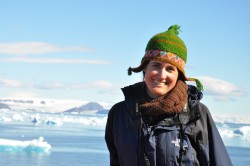Hunting for Dinosaurs in Antarctica
October 11, 2016

An international team of researchers journeyed to Antarctica in February 2016 to search for evidence that the now-frozen continent may have been the starting point for some important species that roam the Earth today.
Millions of years ago Antarctica was a warm and lush environment ruled by dinosaurs and inhabited by a great diversity of life. But today, the fossils that could reveal what prehistoric life was like are mostly buried under the ice of the harsh landscape, leaving the part that Antarctica played in the evolution of vertebrates as one of the great unknowns in the history of life.
Leading the team were paleontologists from the Jackson School of Geosciences, Carnegie Museum of Natural History, Ohio University and the American Museum of Natural History. Other collaborators included scientists from museums and universities across the U.S., Australia and South Africa. Aided by helicopters, scientists conducted research on James Ross Island and other nearby islands off the tip of the Antarctic Peninsula, one of the few spots in Antarctica where fossil-bearing rocks are accessible.
The team was specifically searching for fossils from the Cretaceous through Paleogene, a span of about 100 million to 40 million years ago that includes the end of the Age of Dinosaurs and the beginning of the Age of Mammals. Among the questions the team hopes to answer: Did Antarctica play a critical part in the origins of certain modern bird and mammal groups, or was the evolution of species there more similar to what was happening in other parts of the world?
The expedition was part of a research initiative funded by the National Science Foundation.
“It’s impossible not to be excited to reach remote sites via helicopter and icebreaker to look for dinosaurs and other life forms from over 66 million years ago,” said Julia Clarke, a professor and paleontologist in the Department of Geological Sciences. “The Earth has undergone remarkable changes, but through all of them, life and climate and geologic processes have been linked. A single new discovery from this time period in the high southern latitudes can change what we know in transformative ways”
Back to the Newsletter